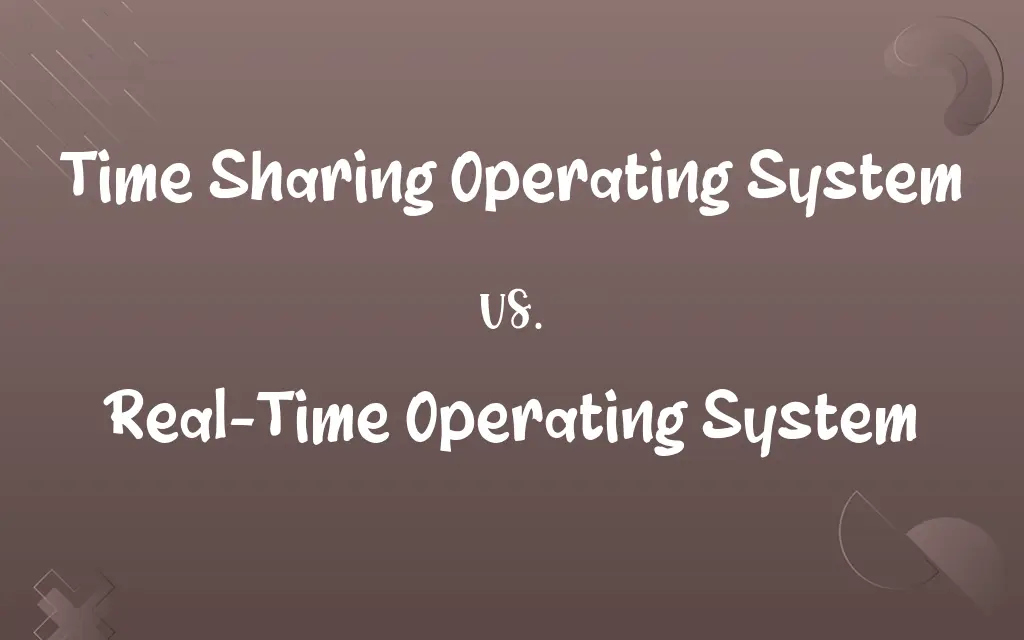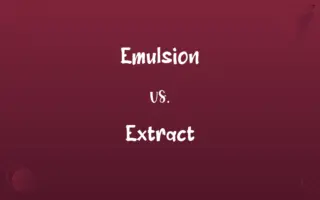Time Sharing Operating System vs. Real-Time Operating System: Know the Difference

By Shumaila Saeed & Dua Fatima || Published on November 18, 2024
Time-Sharing OS allows multiple users to access a computer's resources concurrently, optimizing for fairness. Real-Time OS ensures timely task execution, critical for systems requiring immediate response.

Key Differences
Time-Sharing Operating Systems (TSOS) are designed to provide a multitasking environment where multiple users can access and use the computer resources simultaneously. This is achieved by allocating a specific time slice to each task, ensuring that all users or tasks receive a fair amount of computing time. Real-Time Operating Systems (RTOS), however, prioritize the timely execution of tasks to meet strict timing constraints, crucial for applications where delays cannot be tolerated.
Dua Fatima
Nov 18, 2024
TSOS aims to maximize user interactivity and system efficiency by efficiently managing the CPU's time among all users or processes. This often involves complex scheduling algorithms to balance load and optimize performance. In contrast, RTOS focuses on predictability and reliability, often employing priority-based scheduling to ensure that high-priority tasks are completed within their deadline, sacrificing overall system throughput if necessary.
Dua Fatima
Nov 18, 2024
One key difference lies in their approach to task management and scheduling. TSOS uses time quantum to share processor time among tasks, leading to a responsive but not necessarily immediate execution environment. RTOS, on the other hand, may use a preemptive scheduling strategy to interrupt a currently running task to start or resume a higher-priority task, ensuring that critical tasks meet their deadlines.
Shumaila Saeed
Nov 18, 2024
Error handling and system stability are crucial in both systems but are approached differently. TSOS must ensure fair access while maintaining system stability, often allowing for some degree of error recovery and user feedback. RTOS, given its critical applications in areas like medical devices, automotive control systems, and industrial control systems, requires robust error handling mechanisms to prevent failures that could lead to catastrophic outcomes.
Shumaila Saeed
Nov 18, 2024
TSOS are generally more flexible and used in general-purpose computing environments such as academic institutions, business data processing, and interactive applications, RTOS are employed in mission-critical environments where failure to process data within a specified time frame could result in loss of life, property damage, or environmental harm. This fundamental difference in application domains highlights their tailored design principles and operational objectives.
Dua Fatima
Nov 18, 2024
ADVERTISEMENT
Comparison Chart
Objective
Maximize resource utilization and fairness among multiple users
Guarantee task execution within specified time constraints
Dua Fatima
Nov 18, 2024
Scheduling
Time slice allocation, often round-robin or priority-based
Priority-based, often preemptive
Shumaila Saeed
Nov 18, 2024
Task Execution
Responsive, with possible delays
Immediate, with strict adherence to deadlines
Shumaila Saeed
Nov 18, 2024
Use Case
General-purpose computing, multi-user environments
Mission-critical applications, industrial control
Hifza Nasir
Nov 18, 2024
Error Handling
Provides recovery mechanisms, prioritizes stability
Requires robust mechanisms, cannot tolerate failure
Shumaila Saeed
Nov 18, 2024
ADVERTISEMENT
Time Sharing Operating System and Real-Time Operating System Definitions
Time Sharing Operating System
Designed for flexibility in task management.
TSOS systems dynamically allocate resources to balance load among active processes.
Hifza Nasir
Feb 26, 2024
Real-Time Operating System
Demands high reliability and predictability.
Aircraft control systems use RTOS to maintain strict timing for system stability.
Hifza Nasir
Feb 26, 2024
Time Sharing Operating System
Aims for efficiency and user responsiveness.
TSOS like Linux optimize for performance while handling multiple user requests.
Shumaila Saeed
Feb 26, 2024
Real-Time Operating System
Ensures tasks complete within strict time constraints.
RTOS is used in an airbag system to guarantee rapid response upon impact.
Dua Fatima
Feb 26, 2024
Time Sharing Operating System
Employs time slices to share CPU among tasks.
In a TSOS, the operating system switches between tasks, giving the illusion of concurrent execution.
Dua Fatima
Feb 26, 2024
ADVERTISEMENT
Real-Time Operating System
Critical for safety-sensitive applications.
Medical devices rely on RTOS for precise timing in monitoring and treatments.
Shumaila Saeed
Feb 26, 2024
Time Sharing Operating System
Allows multiple users to use a computer simultaneously.
Unix is a TSOS that supports different users running applications at the same time.
Shumaila Saeed
Feb 26, 2024
Real-Time Operating System
Utilizes priority-based task scheduling.
In RTOS, critical sensor data processing is prioritized over less urgent tasks.
Shumaila Saeed
Feb 26, 2024
Time Sharing Operating System
Supports interactive applications and services.
Windows OS enables various applications to run simultaneously for different users.
Shumaila Saeed
Feb 26, 2024
Real-Time Operating System
Offers minimal delay in task execution.
RTOS in industrial robots ensures tasks are performed in precise, real-time cycles.
Shumaila Saeed
Feb 26, 2024
Repeatedly Asked Queries
What is a Time-Sharing Operating System?
A TSOS allows multiple users or tasks to access the computer resources concurrently by dividing the CPU time among all tasks efficiently.
Dua Fatima
Nov 18, 2024
How do scheduling strategies differ between TSOS and RTOS?
TSOS often uses time slices or priority for task scheduling, while RTOS prioritizes tasks based on urgency, using preemptive scheduling.
Dua Fatima
Nov 18, 2024
Can RTOS be used for general computing purposes?
While possible, RTOS is not optimized for general computing due to its focus on real-time constraints, making it less flexible for non-critical tasks.
Shumaila Saeed
Nov 18, 2024
What is a Real-Time Operating System?
An RTOS is designed to handle tasks that require immediate processing, ensuring tasks are completed within strict timing constraints.
Shumaila Saeed
Nov 18, 2024
Why is error handling more critical in RTOS?
Given its use in mission-critical systems, RTOS must have robust error handling to prevent failures that could lead to serious consequences.
Hifza Nasir
Nov 18, 2024
What makes RTOS suitable for industrial applications?
RTOS's ability to guarantee task execution within precise timing makes it ideal for controlling industrial machinery, ensuring operational accuracy and safety.
Shumaila Saeed
Nov 18, 2024
What are the implications of using an RTOS in automotive systems?
Using an RTOS in automotive systems ensures that critical functions, such as braking and airbag deployment, respond instantly and reliably, enhancing vehicle safety.
Shumaila Saeed
Nov 18, 2024
Are there examples of TSOS in everyday use?
Most modern operating systems like Windows, macOS, and various Linux distributions function as TSOS in personal and professional computing environments.
Dua Fatima
Nov 18, 2024
How does user experience differ between TSOS and RTOS?
TSOS aims to maximize user satisfaction in a multi-user environment with efficient resource sharing, while RTOS focuses on meeting timing requirements, possibly at the expense of system throughput.
Hifza Nasir
Nov 18, 2024
Is Linux considered a TSOS or RTOS?
Linux is primarily a TSOS, but with certain modifications, it can be adapted to serve as an RTOS for specific applications.
Hifza Nasir
Nov 18, 2024
Share this page
Link for your blog / website
HTML
Link to share via messenger
About Author
Written by
Shumaila SaeedShumaila Saeed, an expert content creator with 6 years of experience, specializes in distilling complex topics into easily digestible comparisons, shining a light on the nuances that both inform and educate readers with clarity and accuracy.
Co-written by
Dua Fatima






































































